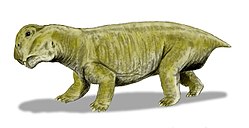| Zambiasaurus Temporal range: | |
|---|---|
| Scientific classification | |
| Kingdom: | Animalia |
| Phylum: | Chordata |
| Clade: | Synapsida |
| Clade: | Therapsida |
| Clade: | † Anomodontia |
| Clade: | † Dicynodontia |
| Family: | † Stahleckeriidae |
| Subfamily: | † Placeriinae |
| Genus: | † Zambiasaurus Cox, 1969 |
| Species: | †Z. submersus |
| Binomial name | |
| †Zambiasaurus submersus Cox, 1969 | |
Zambiasaurus [1] is an extinct genus of dicynodonts that was discovered in the Middle Triassic (Anisian) Ntawere Formation of Zambia, southern Africa. It was a large dicynodont, reconstructed using several fossil fragments, in majority belonging to probably a juvenile Zambiasaurus submersus.
Contents
- Description
- Skull
- Post-cranial elements
- Classification
- History
- Paleobiology
- See also
- References
- External links
Zambiasaurus submersus [2] is the type species of the genus Zambiasaurus. It is a stahleckeriid, the first stahleckeriid known outside South America, and it is also the oldest known stahleckeriid. [3]





